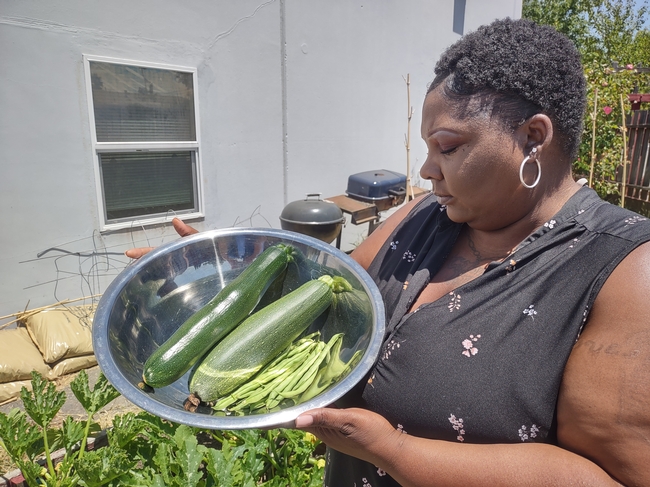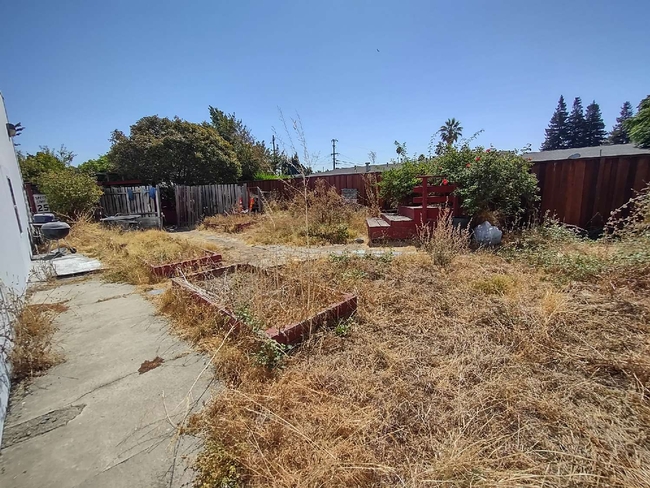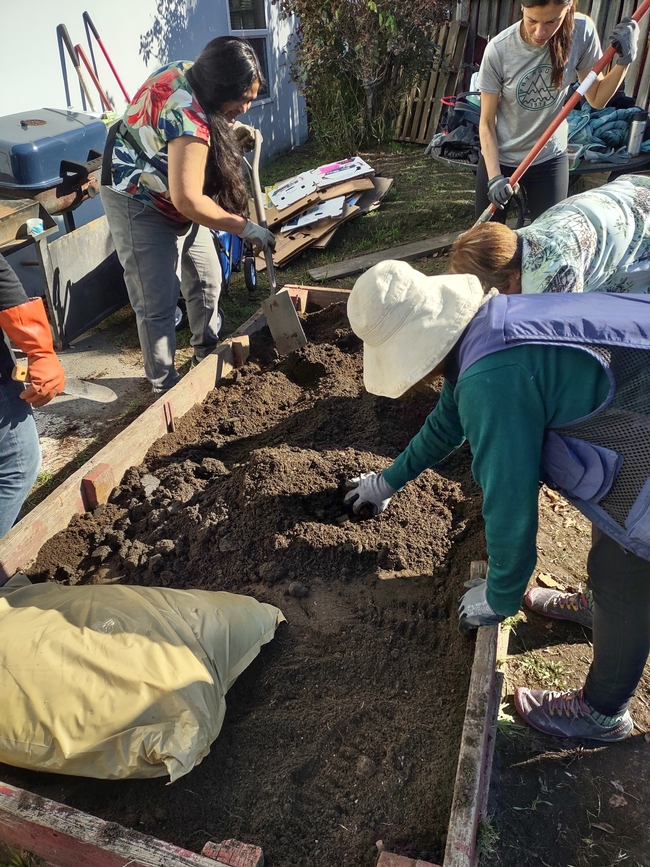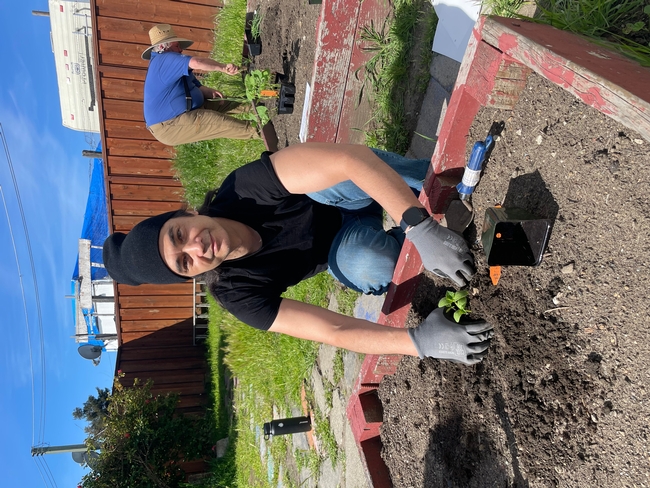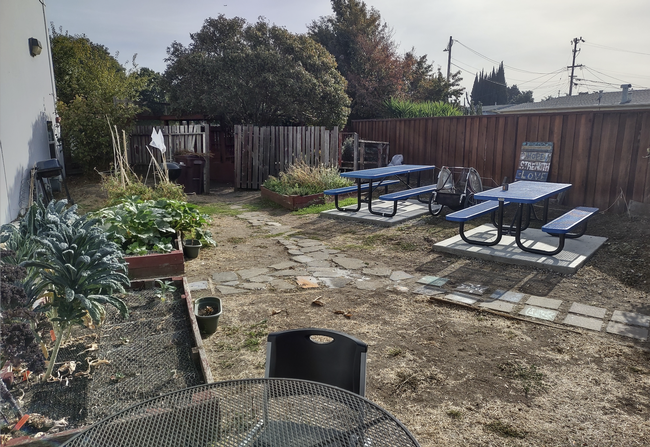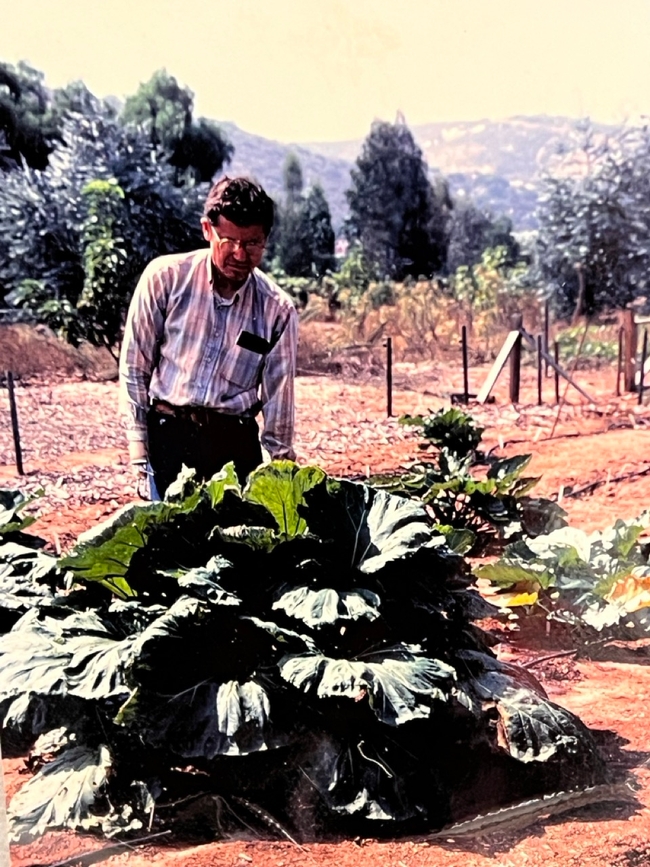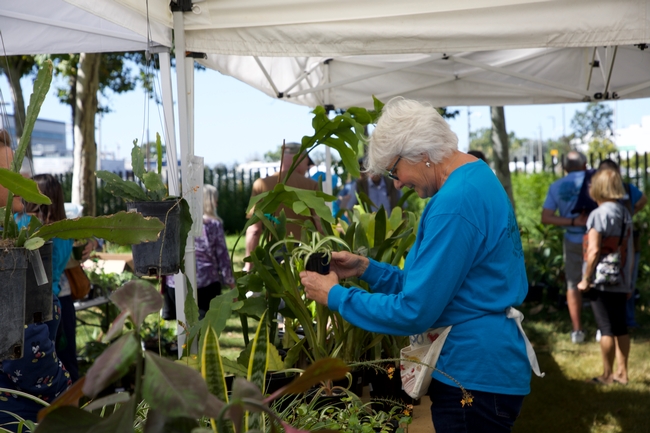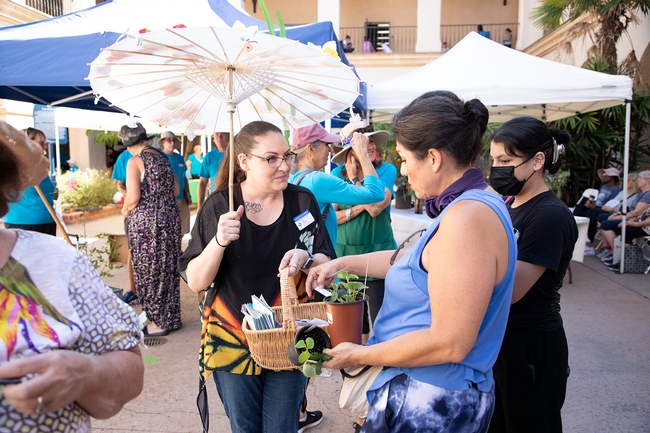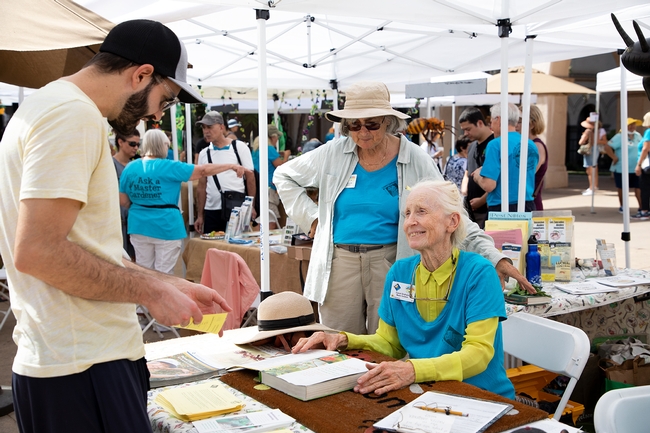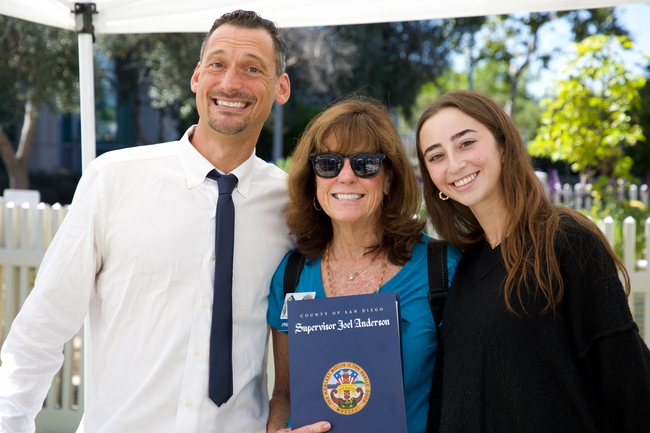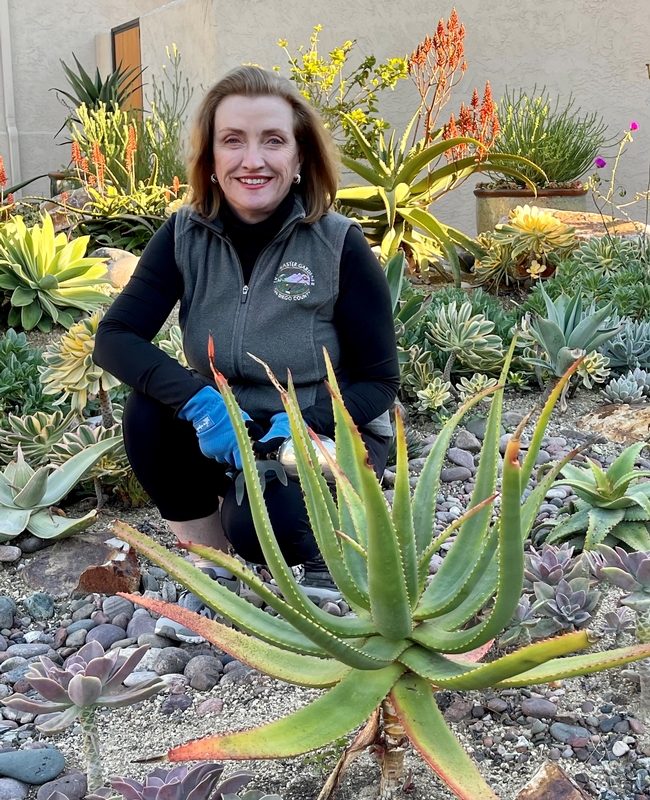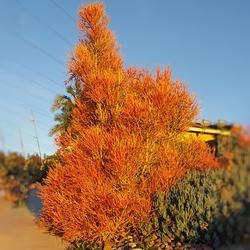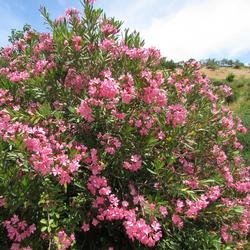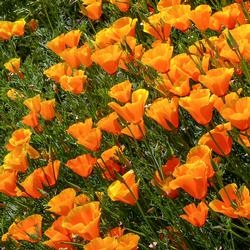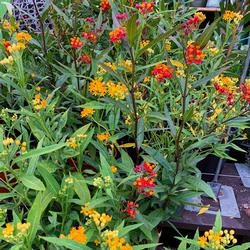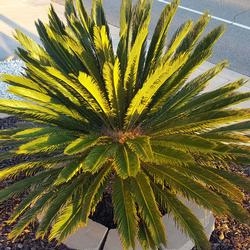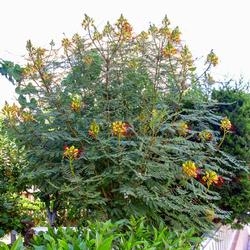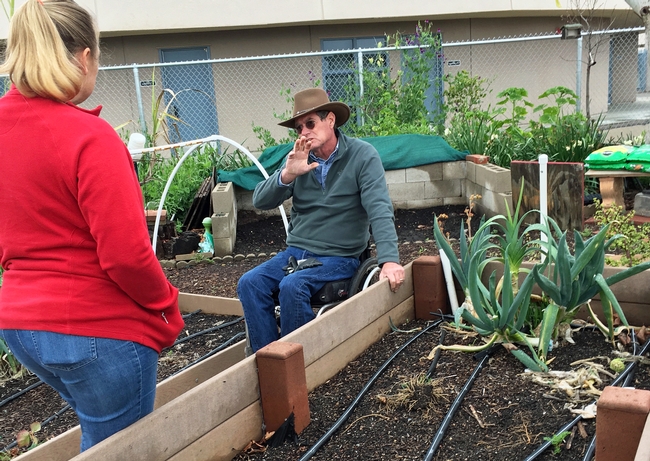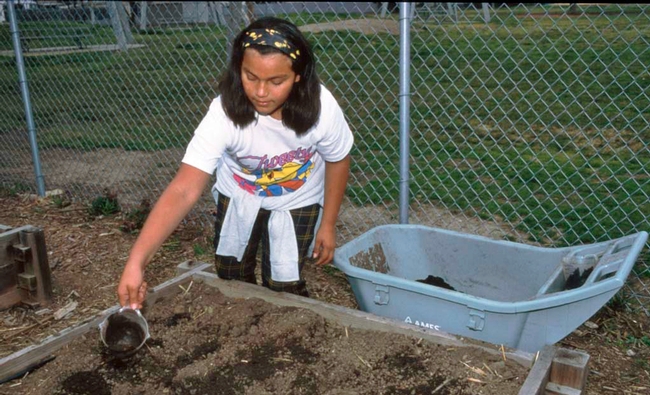
Posts Tagged: UC Master Gardeners
Homeless people cultivate food, better health while gardening in Alameda County
Fresh fruits and vegetables are essential to a healthful diet, but it's hard to keep perishable foods on hand if one doesn't have a refrigerator or a home. To enhance the health of homeless people, the CalFresh Healthy Living, UC Cooperative Extension team in Alameda County has partnered with the South County Homeless Project to grow fresh produce for people staying at the emergency housing in Hayward.
For the past seven years, CalFresh Healthy Living, UCCE Alameda has been delivering nutrition lessons to residents of the South County Homeless Project, part of Building Opportunities for Self Sufficiency. The classes include Rethink Your Drink, Food Safety, Making Every Dollar Count, Eat Healthy Be Active Community Workshops, and Fresh from the Garden.
The South County Homeless Project facility houses 24 people for up to a year. With the help of the CalFresh Healthy Living, UC Cooperative Extension team, its existing garden was refurbished and redesigned. The large outdoor garden behind the facility offers therapeutic gardening opportunities to residents and provides food for their meals.
"I love the garden and when the cook cooks the vegetables, they taste amazing,” said one resident. “I am thankful for this garden and for having the CalFresh Healthy Living team.”
At one time, South County Homeless Project's backyard featured a flower garden. After years of neglect, weeds overtook the garden.
In 2022, CalFresh Healthy Living, UCCE Alameda proposed getting residents involved in growing food by resurrecting the garden with edible plants.
“Not only could we continue to engage residents in nutrition education classes, but we could also work together to reinvigorate their neglected garden,” said MaxFairbee, nutrition educator withCalFresh Healthy Living team,UCCE Alameda.
More than 15 varieties of herbs and vegetables planted
Residents and staff set out to replace the weedy beds with a vegetable and herb garden.
“We worked with South County staff and residents on the design, clean up, planting, harvesting and ultimately incorporating food from the garden into the kitchen for residents to enjoy the fruits of their labor,” Fairbee said.
For gardening expertise and support, Fairbee enlisted the UC Master Gardeners of Alameda County's Community Garden Team to help. While the CalFresh Healthy Living, UCCE staff continued providing nutrition classes, the UC Master Gardener volunteers trained the residents on the basics of gardening.
In April, after heavy rains, the group planted 50 seedlings, half donated by the UC Master Gardeners. They planted two varieties of lettuce,arugula, four varieties of tomatoes, zucchini, kale, onions, cucumbers, green beans, Swiss chard, kale, basil, cilantro, tarragon, thyme, parsley, rosemary, oregano and mint.
From garden to table
“In May, we harvested lettuce and in June, we harvested green beans, cucumbers, kale and onions,” Fairbee said.
The fresh vegetables and herbs were used to prepare salads, sandwiches and pasta dishes for the residents. Fairbee and the other educators have also used the fresh produce for cooking demonstrations and tastings as part of their Fresh from the Garden class.
"We have been able to use many of the veggies as sides or to go in the salad," said one of the South County Homeless Project cooks.
"One of the chefs used the zucchini in the pasta sauce, it was so good! I didn't really know you could use it that way!" said a resident.
After tasting summer squash andgazpacho made with tomatoes from the garden, a South County resident namedSelina said, "I was surprised how good the raw summer squash tasted and how the flavor was different after it was cooked. I'll definitely be adding more zucchini to my plate."
Challenges to keeping the garden going
To keep the garden healthy, they faced competition with plant-chewing snails, slugs and aphids and cats digging in the soil. Because the water source is over 200 feet from the garden, they run a long hose across the main path, along the parking lot to water the plants, then unhook the hose and stash it indoors after each use so that it won't get stolen.
Another challenge of maintaining the garden is getting enough residents and staff to volunteer to work on it.
“Although staff are supportive of the garden, none actually have time to work in the garden,” Fairbee said.
The residents harvest, wash and store the produce in the kitchen. Only four to six of the 24 residents are typically interested in working in the garden, pulling weeds and protecting the plants from pests – most are focused on getting a new job and a home. South County residents usually leave the temporary housing within a few months.
For more consistent garden maintenance, Fairbee is looking to other community groups for volunteers. He is also hoping to persuade the county government to install a water spigot close to the garden so they can install drip irrigation to water the garden.
“We'd like to work with the UC Master Food Preservers to teach residents how to preserve herbs and vegetables,” Fairbee said.
He hopes South County Homeless Project residents will continue gardening in their new homes to grow fresh vegetables so they can enjoy a more nutritious diet and better health.
Beyond the fresh food, the South County Homeless Project residents and staff enjoy the ambience of the garden.
"It's really nice to go back there and just sit, it's really peaceful," said one staff member.
A resident added, "(The garden) relaxes me from stress. I love the garden."
UC Master Gardeners of San Diego celebrates 40 years of service to community
For 40 years, the University of California Master Gardener Program of San Diego County has upheld its mission of providing research-based information about home horticulture and pest management to the public, while earning and sustaining the community's trust in doing so.
“People trust UC Master Gardeners to provide accurate advice on gardening because they are trained by UC ANR [UC Agriculture and Natural Resources],” said Vincent Lazaneo, emeritus urban horticulture advisor and the first UC Master Gardener program coordinator for San Diego County.
The UC Master Gardener program, a public service and outreach program under UC ANR, is administered by local UC Cooperative Extension offices and outreach is provided by trained volunteers. In 1983, the UC Master Gardener program of San Diego County started with about 30 volunteers. Today, more than 350 volunteers serve the program, which is now managed by program coordinator Leah Taylor.
In San Diego, UC Master Gardeners have had a significant presence in schools, where they encourage an appreciation for plants and our planet; at the county fair where they field hundreds of questions related to plant care; and in community spaces such as Balboa Park and the Carlsbad Flower Fields where they staff demonstration gardens.
“Having the UC behind us is huge,” said Anne Perreira, UC Master Gardener and current president of the Master Gardener Association of San Diego County. “It opens doors for us and gives us credibility.”
'Dual citizenship' status expands capacity for support
When Lazaneo started the UC Master Gardener program in 1983, he felt the need to establish a formal association or 501(c)(3) nonprofit organization that would support the program.
Unsure of what the future held, Lazaneo believed that nonprofit status would increase the UC Master Gardeners' flexibility regarding project development, community engagement and financial planning. After 10 years, the UC Master Gardeners of San Diego County were approved as a registered nonprofit organization and became simultaneously known as the Master Gardener Association of San Diego County.
“It can be confusing for people when they hear that we're a UC program and an association,” explained Taylor. “It's like ‘dual citizenship' in a way, and I think the most important thing to know is that our status as a nonprofit and affiliation to UC work in conjunction to not only support the UC Master Gardeners and what they do in San Diego, but their ability to support UC Master Gardener programs in other counties.”
Emphasizing the research-based approach
Taylor, who has been the program coordinator since 2021, said that the UC Master Gardener program is instrumental in extending the work of UCCE advisors. “If you're working on research and you need to get that information out into the public, we've got 350 UC Master Gardeners who are trained and available to communicate on your behalf,” Taylor said.
“For me it's like a multiplier effect: how many San Diegans can I reach by teaching a seminar on small-scale hydroponics? Maybe 20 or 30,” said Gerry Spinelli, UC Cooperative Extension production horticulture advisor for San Diego County. “But how many can I reach by training 20 or 30 UC Master Gardener volunteers on the same topic? Maybe 200 or 300.”
Spinelli, who also advises the UC Master Gardeners for San Diego County, said that the group has been instrumental in data collection and disseminating information to the public, particularly in urban underserved areas.
Lazaneo recalls the UC Master Gardeners establishing a partnership in 1983 with Cuyamaca College in El Cajon. The college's Horticulture Department allowed the UC Master Gardeners to develop a research garden on campus. After setting a perimeter, building a fence, installing irrigation lines and rototilling the soil, the UC Master Gardeners planted different tomato varieties that were used in a statewide study assessing plant performance for home gardens.
In addition to educating and equipping the public, the UC Master Gardeners of San Diego County have contributed to research efforts on specific crops, including the development of a new artichoke variety, Imperial Star, with guidance from Wayne Schrader, former UCCE vegetable crops advisor for San Diego County.
The research garden, which was used for more than a decade, also aided in research efforts evaluating asparagus varieties, horned cucumbers called “Kiwano,” a fruit similar to melon called pepino dulce, sweet peas, rhubarb and many others. Similarly, the research garden has contributed to trials for soil solarization and chemical treatment to control root knot nematodes and expanded understanding of powdery mildew's impact on summer squash.
Evolving with the times
Out of 170 applications, Lazaneo selected about 30 individuals to be a part of the first class of UC Master Gardeners for San Diego County. Carol Graham, who is still active today, was in the original cohort that formed in 1983.
Graham said that “times have certainly changed,” and one of the changes she's noticed since joining UC Master Gardeners is the proliferation of insects. “I don't remember pests being a severe issue when I first started. Now, you've got all kinds of bugs that have moved into the county, causing people to overuse and misuse pesticides,” said Graham.
Graham's 40 years as a UC Master Gardener have given her an opportunity to teach people how to overcome their phobias of bugs and how to use pesticides safely and appropriately. Furthermore, her role as a UC Master Gardener has allowed her to teach others how to grow their own food in hopes of enhancing food security in the county, something she cares deeply about.
The UC Master Gardeners also have changed the way they communicate over the years. DeLayne Harmon, vice president of member services, is well-versed in the program's history.
“Before we began tracking our volunteer hours online, do you know what the UC Master Gardeners did back in the day?” asked Harmon, who joined UC Master Gardeners in 2020. “They wrote everything down by hand, with pen and paper!”
“It's easy to have the mentality that's like, ‘This is how we've always done things,'” said Harmon. “But the UC Master Gardeners know that there is always room for improvement, and we welcome opportunities to be better.”
Giving back and putting people first
The UC Master Gardeners of San Diego County are eager to improve access to fresh food in schools. Recently, the UC Master Gardeners were given a $5,000 grant by the Sage Garden Project, which will be used to partner with schools in under-resourced communities.
“We want to be in places where the people don't know about UC Master Gardeners,” said Perreira, the association president. “We realized that there are a lot of students who don't know what fresh food looks like and we want to change that.”
In 2022, the UC Master Gardeners transformed a landfill into a demonstration garden, now called the Paradise Hills Native Garden, which they also maintain. “It's beautiful and there are walking trails for the community to enjoy,” Taylor said. “The native garden is in a neighborhood that doesn't have a lot of green space, and to have something so beautiful, that encourages community gatherings, it's a good thing.”
Looking to the future of the UC Master Gardener program in San Diego, Taylor says that she wants to continue making an impact in the community and having the UC Master Gardeners be that driving force.
Grateful for Taylor's leadership, Spinelli said that he is excited about the program's impact on food education, particularly in food deserts.
“We are blessed with a climate that allows year-round food production, and with the science-based knowledge offered by the UC system, our UC Master Gardeners can provide San Diego County residents with the tools to grow local, healthy, nutritious, safe and environmentally friendly food for their families,” Spinelli said.
When reflecting on how far the UC Master Gardeners of San Diego County have come, Perreira – who has been a UC Master Gardener since 2016 – emphasized how important it is to continue their legacy of doing good in and with the community. “We've got a diversity of skills within our group and I'm ready for us to expand our capacity to create change. What we do and what we say have to mean something!” she said.
To read this story in Spanish, visit: https://ucanr.edu/blogs/blogcore/postdetail.cfm?postnum=59028
Drought-tolerant plants can save water, but beware of those that are toxic
UC Master Gardener Francie Murphy was pruning the succulents in her San Diego front yard when an unfortunate accident catalyzed her commitment to communicating the dangers of toxic plants. She trimmed a stem on her drought-tolerant pencil milk bush and milky sap spurted into one eye, causing stinging pain.
“I tried to wipe it out, and in doing so got in both eyes. I was blinded. The pain was unbelievable,” she said.
A nearby friend rushed her to the emergency room where the doctor diagnosed chemical burns to her corneas and washed her eyes with two liters of saline water each. Murphy removed the plant from her garden, but saw it growing throughout her community.
“I knew we had to do something,” she said.
Drought-tolerant plants like cacti, yucca, agaves and aloes have adaptations to protect themselves from wildlife in search of the moisture within their leaves and stems. They have spikes or spines to ward off people and animals. Other plants don't have outward signs of danger. Fire sticks, also known as sticks on fire and pencil cactus and by its scientific name Euphorbia tirucalli, is a very popular succulent in frost-free areas. Its vertical growth habit and showy soft green to reddish-gold stems make it a striking landscape specimen. A native of southern Africa, the smooth, coral-like stems look deceptively harmless. The sap is toxic.
“Fire sticks should be planted far from walkways, in the back of the landscape, where you can see them, but not touch them,” said UC Cooperative Extension natural resources advisor Chris McDonald. “When trimming the plant, wear long pants, long sleeves and eye protection. If the plant is tall, consider protecting your face.”
After Murphy shared her story about these plants with other Master Gardeners, UCCE San Diego gathered a team and worked with colleagues to secure funding from the County of San Diego to develop a website and handouts to inform the community about readily available yet toxic drought-tolerant plants being planted into California landscapes.
The handout can be downloaded from the Plant Safely website (https://ucanr.edu/sites/PlantSafely/). The materials were quickly distributed to nurseries, garden events and Master Gardener help booths, such as at farmers markets, home shows and fairs, and other educational events. A key feature of the website is a database of nearly 100 plants (which can be found here) with photos and descriptions that explain how they are unsafe and how they can be used safely in the landscape. (https://ucanr.edu/sites/PlantSafely/Common_Names/)
Some common yet toxic landscape plants included in the database are:
“These potentially harmful plants are grown widely in many parts of California,” McDonald said. “It's important to promote drought-tolerant landscapes, and we must also do it in a way that preserves public health.”
View the UC Master Gardener video about safely planting fire sticks (Euphorbia tirucoli):
UC Master Gardener helps make San Diego gardens friendly and inclusive
Stephen Cantu, a UC Master Gardener in San Diego County UC Cooperative Extension, is well aware of ways to improve accessibility and inclusiveness in gardening for people with mobility issues, reported Lisa Deaderick in the San Diego Union-Tribune.
Cantu, who has used a wheelchair for 37 years due to a job site accident, identifies obstacles and solutions that help people of all abilities benefit from the joys of tending a home garden. He is active in the UCCE Master Gardener Association program that assists community members in designing garden spaces for maximum accessibility called Friendly Inclusive Gardening (FIG).
FIG teaches people how to implement the principles of universal design to make home, school and community gardens safer and more accessible to people with physical disabilities, seniors with mobility issues and young children. A workshop scheduled for March 21 had to be postponed in order to comply with efforts to reduce the spread of COVID-19, so Deaderick published a Q&A with Cantu to share how people can start a small garden at home while waiting out the coronavirus.
He said FIG is not just for wheelchair users. "In other words, a garden designed for the whole family to use, from young children to grandma and grandpa," Cantu said.
He recommends new gardeners start simple and build on success.
"Start out with a small kitchen garden of mostly herbs, something that is in small containers that you can grow next to your kitchen. . . Don't buy anything until you have an understanding of your needs. For a small garden, all you really need are your hands, a pair of gloves, some soil, and a few herbs," Cantu said.
Read the whole interview on the San Diego Union-Tribune website and find much more gardening information for many California locations on the UC Master Gardener website.
Gardening provides stress relief in trying times
With many schools are closed due to the coronavirus crisis, families are educating and entertaining children at home. Susan Schena of The Patch provided nine enriching activities for housebound kids; for the third one she turned to UC Master Gardner Louisa R. Cardenas from the Los Angeles County University of California Cooperative Extension for advice.
"There are numerous free sites with kids' gardening and environmental activities," said Cardenas, who chairs the Los Angeles County Master Gardener Program School Garden Network. "While most resources focus on school-yard gardening, many activities may easily be applicable to home gardens or apartment living."
According to a Los Angeles Times article, gardening does more than keep the kids busy and enriched. It can relieve stress associated with trying times. The article cited research in the Netherlands in which a test group performed a stressful activity for 30 minutes, and then were randomly assigned them to garden outside or read a book indoors. The study found that both activities reduced the cortisol levels that trigger stress, but the people who gardened saw much lower cortisol levels and their positive mood restored, as opposed to the readers, whose moods got worse.
For gardening advice, Times reporter Jeanette Marantos spoke to Yvonne Savio, the now-retired long-time UC Master Gardener coordinator for UC Cooperative Extension in Los Angeles County. Savio writes the blog GardeninginLA.net.
You can plant your tomatoes in late March, Savio said, but wait until April to plant summer crops like eggplant, peppers and cucumber.
If the soil hasn't warmed up to at least 60 degrees, warm-season seedlings “just sit and pout at you,” Savio said. Worse, she said, the cool temperatures can stunt their future growth, destroying your efforts to get an early harvest.
There are plenty of garden tasks that can be accomplished while waiting for warmer soil. The Times article suggests:
- Feed your soil with good organic amendments such as compost and steer manure or organic potting soil for pots.
- Water it well and wait a week or two before planting, because the organisms create a lot heat as they break down, and can burn your tender seedlings. You'll know the soil is safe for planting when the temperature feels comfortable to your bare hand, said Savio.
- Try Savio's technique of burying 5-gallon nursery buckets among your plants (the kind with holes already in the bottom). Make sure the rim of the buckets are about 4 inches above ground, so you have room for mulch, and then fill those buckets with water once or twice a week to force moisture — and roots — deeper into the ground.
For more at-home gardening information, find your local UC Master Gardener program website here:
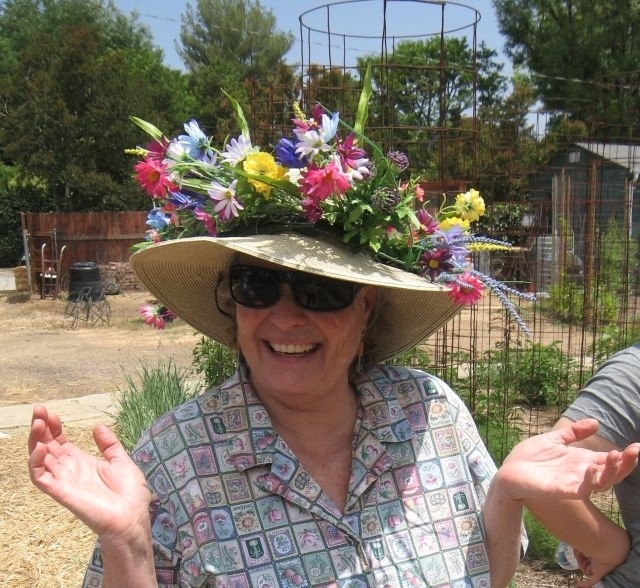
Yvonne Savio now volunteers as a UC Cooperative Extension Master Gardener.

